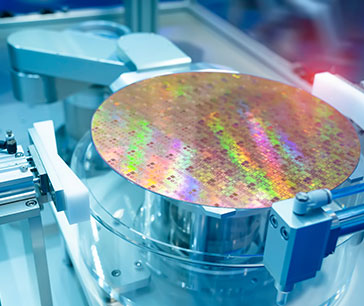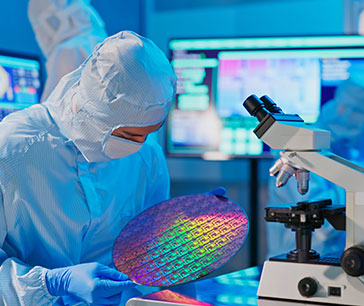Table Of Contents
- Global Semiconductor & Electronics Industry Outlook
- Technological Advancements: Pushing Boundaries in Chip Design and Manufacturing
- Technological Advancements: Anticipating the Future in the Electronics Industry
- Sustainability and Green Practices: Transforming Industry Practices
- 2024 Vision: Key Trends Shaping the Future Landscape
- Workforce and Talent Management: Building a Resilient Future
- Digital Transformation: Embracing Industry 4.0 Revolution
- Regulatory and Economic Factors: Navigating a Complex Terrain
- Challenges and Risks: Navigating the Road Ahead
- Innovation in Materials and Processes: Redefining the Semiconductor Landscape
- Looking Forward: Welcoming Change and Shaping the Future

Sonia Mutreja

Pooja Parvatkar
2024 Vision: Semiconductor & Electronics Industry’s Comprehensive Brief

In 2023, the semiconductor and electronics sector experienced a dynamic era of progress, characterized by rapid advancements and transformative innovations. Breakthroughs in semiconductor technology, coupled with the surge in demand for electronic devices, have propelled the industry to new heights. In 2024, emerging technologies, such as 5G, artificial intelligence, and the internet of things (IoT) are predicted to reshape the landscape, fostering unprecedented connectivity and efficiency. The sector’s resilience and adaptability are playing a pivotal role in navigating global challenges. As it continues to evolve, the semiconductor and electronics sector stands at the forefront of technological evolution, driving economic growth and shaping the future of a digitally connected world.
Global Semiconductor & Electronics Industry Outlook
After an uncertain couple of years, the global semiconductor and electronics industry is expected to bounce back and poised for significant growth in 2024. The increasing demand for semiconductor chips in emerging technologies, such as artificial intelligence (AI), Internet of Things (IoT), and 5G networks and growing demand for smart devices are projected to boost the sector’s growth.
Drivers
The relentless march of innovation, particularly in areas like artificial intelligence (AI), 5G technology, and the Internet of Things (IoT), serves as a formidable driver for the global semiconductor market. The widespread adoption of these technologies in applications ranging from smart devices to industrial automation propels demand. Moreover, the global push towards sustainability and green energy solutions elevates the significance of semiconductor technologies in developing energy-efficient solutions.
Opportunities

Opportunities in this dynamic landscape abound, especially with the automotive industry’s shift towards electric vehicles and advanced driver assistance systems (ADAS). The increasing reliance on connected devices, coupled with the rising demand for high-performance computing in data centers, opens new frontiers for semiconductor and electronics manufacturers. Exploring innovative solutions in healthcare, consumer electronics, and industrial automation further expands the industry's scope.
Technological Advancements: Pushing Boundaries in Chip Design and Manufacturing
In 2024, technological advancements will propel chip design and manufacturing, pushing boundaries with relentless innovation. The transformative year will mark a relentless pursuit of miniaturization, ensuring the semiconductor industry remains at the forefront of technological evolution, driving advancements in AI-powered devices and shaping a more efficient future.
- Advanced Chip Design and Manufacturing: Moore's Law may be nearing its limits, but the human quest for miniaturization marches on. Chipmakers will continue to shrink transistor sizes, pushing the boundaries of technology by venturing into 3nm and even 2nm nodes. This relentless pursuit of miniaturization promises faster, more efficient chips that power everything from AI-powered smartphones to self-driving cars.
- Quantum Computing Developments: The whispers of quantum computing are growing louder, with 2024 expected to bring significant advancements in research and development. Early-stage quantum prototypes may emerge, unlocking unprecedented computational power. The growing preference for the software as a service (SaaS) business model, expanding datacenter workloads and the increasing complexity in processor design are the factors predicted to boost the growth of the quantum computing market.
- AI Integration in Semiconductor Design: Artificial intelligence, the ubiquitous force transforming industries, is now poised to revolutionize semiconductor design itself. By leveraging AI algorithms, companies can automate tedious tasks, optimize layout processes, and predict potential challenges, ultimately accelerating chip development and delivering higher-performing products.
Technological Advancements: Anticipating the Future in the Electronics Industry
Despite facing global economic challenges in 2023, the electronics industry showcased resilience and growth, outpacing many economies worldwide. As we step into 2024, the focus for original equipment manufacturers (OEMs) and electronic businesses shifts to keeping pace with relentless technological evolution shaping our world.
- Generative Artificial Intelligence (AI): In 2023, generative AI emerged prominently, presenting exciting opportunities across sectors. In 2024, the electronics industry is poised to leverage AI, particularly in electronic design. Evolving tools like Copilot facilitate context-aware project insights, offering designers comprehensive analysis, feedback, and advice, streamlining hardware design processes.
- Wearable Devices: In 2024, augmented reality (AR) wearables, like smart glasses and contact lenses, are set to revolutionize how we perceive and interact with the world. AR wearables offer real-time information and enhance safety in industrial settings, reflecting a shift from conventional wearables. The global wearable technology market is projected to reach $184,403.60 million by 2031.
- Digital Twins: Addressing operational inefficiencies, 2024 is expected to introduce the power of digital twins. Integrated with IoT, AI, and sensors, digital twins aid experimentation and optimization, providing manufacturers valuable insights for efficient production methods. The global digital twin industry is anticipated to grow at a CAGR of 2022 to 2030.
Sustainability and Green Practices: Transforming Industry Practices
In a transformative shift, sustainability and green practices are revolutionizing industry norms. The semiconductor sector is witnessing a crucial reevaluation, surpassing the mere buzzword status. Manufacturers are embracing eco-friendly practices, incorporating renewable energy sources, water conservation initiatives, and responsible e-waste disposal.
- Emphasis on Sustainable Manufacturing: Sustainability has become a critical necessity for semiconductor and electronics manufacturers, moving beyond its status as a mere buzzword. A significant shift towards environmentally friendly practices is expected. This includes an increased dependence on renewable energy sources, initiatives aimed at water conservation, and responsible methods for electronic waste disposal. Furthermore, manufacturers are likely to invest in research and development to discover more sustainable manufacturing processes, reducing the overall carbon footprint of the industry. For instance, Infineon plans to reduce greenhouse-gas (GHG) emissions by 70 percent by 2025, compared with its 2019 baseline, and aspires to reach carbon neutrality for emissions directly under its control by the end of 2030.
- Energy-Efficient Chip Solutions: As global energy concerns continue to intensify, the demand for energy-efficient chips is expected to skyrocket. Companies are likely to prioritize the development of low-power processors, technologies for memory optimization, and innovative circuit designs that reduce energy usage while enhancing performance. Additionally, the industry might see a rise in collaborations and partnerships aimed at developing advanced, energy-efficient solutions. This not only addresses the energy concerns but also contributes to the industry's overall sustainability goals. For instance, IBM’s researchers have designed what they claim to be the world’s first four-core AI accelerator chip that is built on high-performance seven-nanometer technology, while also achieving high levels of energy efficiency. By 2032, the global artificial intelligence chip market is projected to reach $383.7 billion, increasing from was valued at $14.9 billion in 2022.
2024 Vision: Key Trends Shaping the Future Landscape
Surge in Adoption of ADAS & Infotainment Driving Automotive Semiconductors

The automotive semiconductor market continues its robust growth and the intertwining trends of automotive intelligence and electrification ensure a long-term and steady demand for semiconductors, with Infotainment contributing significantly to this growth story.
Semiconductor AI Applications Proliferate: From Data Centers to Personal Devices
The integration of AI functions into smartphones, PCs, and wearables will stimulate increased demand for semiconductors and advanced packaging, ushering in a new era of innovative applications for personal electronics.
The End of IC Design Inventory Depletion, Asia-Pacific Market to Grow in 2024

Despite a sluggish performance in 2023, IC designers in the Asia-Pacific region are expected to rebound and witness significant market growth in 2024. The recovery is attributed to sustained investments, innovation initiatives, and the gradual revival of the global personal device market.
Rising Need for Home Automation and Smart Appliances
The global home automation sector is predicted to experience a paradigm shift, driven by an increasing need for convenience, energy efficiency, and enhanced security in residential areas.
Soaring Demand for Advanced Processes in Foundry Industry
Efforts from major players like TSMC, Samsung, and Intel, combined with recovering demand for consumer electronics and AI, signal a resurgence in the foundry sector, particularly in advanced processes.
Increasing Demand for Audio Equipment
The audio equipment industry is experiencing a remarkable surge in demand, driven by various factors contributing to its rapid growth.
Advancements in LED Technology
Recent breakthroughs in Light-Emitting Diode (LED) technology are reshaping the lighting industry. The integration of LED technology into smart home platforms allows users to control lighting systems through voice commands or smartphone applications.
Workforce and Talent Management: Building a Resilient Future
In 2024, the semiconductor industry will proactively build a resilient future through strategic workforce and talent management. Recognizing the pivotal role of human ingenuity, the sector will invest in training programs, educational partnerships, and talent development initiatives. This forward-looking approach aims to bridge existing skill gaps and cultivate the next generation of semiconductor engineers and technicians.
- Skilled Workforce Development: Recognizing the industry's dependence on human ingenuity, 2024 will witness increased investments in training programs, educational partnerships, and talent development initiatives to bridge the gap and nurture the next generation of semiconductor professionals.
- Diversity and Inclusion Initiatives: Acknowledging the power of diverse perspectives, the industry is set to intensify efforts in attracting and retaining talent from underrepresented groups. Inclusivity, diverse leadership, and a welcoming culture will take center stage.
Digital Transformation: Embracing Industry 4.0 Revolution
- Industry 4.0 Integration: The semiconductor industry, at the heart of the digital transformation, will witness increased integration of Industry 4.0 principles. Advanced automation, real-time data analytics, and seamless information exchange will optimize production processes and enhance efficiency.
- Cybersecurity Measures: As the industry embraces digital technologies, robust cybersecurity measures will be paramount. Investments will be directed towards protecting sensitive data, intellectual property, and critical infrastructure from cyber threats.
Regulatory and Economic Factors: Navigating a Complex Terrain
The semiconductor and electronics industry will confront a complex terrain shaped by regulatory and economic factors in 2024. Navigating this intricate landscape will demand adept strategies.
- Global Semiconductor Trade Dynamics: The intricate web of global trade will continue to influence the semiconductor landscape. Companies will navigate evolving export-import regulations, geopolitical tensions, and potential trade wars to secure access to critical materials and markets.
- Economic Resilience Strategies: Faced with economic uncertainties, semiconductor companies will develop strategies to mitigate risks associated with fluctuating material costs, adapt to changing market demands, and build resilient supply chains.
- International Collaboration in Research and Development: Recognizing the power of collective innovation, international collaboration in semiconductor research and development will gain momentum. Joint research projects and technology-sharing initiatives will accelerate innovation and address shared challenges.
Challenges and Risks: Navigating the Road Ahead
- Resilience in Supply Chain: The global semiconductor supply chain, susceptible to disruptions, calls for strategies like multiple sourcing options, regionalization of production, and contingency plans to mitigate risks associated with events like pandemics and geopolitical tensions.
- Counteracting Counterfeit Components: The surge in counterfeit semiconductor components necessitates stringent authentication measures, reliable partnerships with suppliers, and collaborative efforts across the industry to ensure the integrity of the supply chain.
Innovation in Materials and Processes: Redefining the Semiconductor Landscape
- Advanced Semiconductor Materials: Beyond silicon, the industry explores innovative materials like graphene and gallium nitride for their potential to create faster, more powerful, and energy-efficient chips.
- Focus on Energy-Efficient Components: Sustainability takes center stage with the development of energy-efficient components, including low-power transistors, energy-harvesting technologies, and innovative circuit designs.
Looking Forward: Welcoming Change and Shaping the Future
The year 2024 marks a significant turning point for the semiconductor industry. It represents an opportunity to welcome change, stimulate innovation, and collaborate towards a promising future. By giving priority to technological advancements, sustainability initiatives, and a skilled workforce, semiconductor companies can not only overcome upcoming challenges but also shape the future of technology. Here are some critical factors to monitor:
- Innovation as a Driving Force: The adoption of a culture of continuous innovation is crucial for maintaining a competitive advantage and exploring new opportunities. Companies need to be receptive to new ideas, invest in research and development, and promote risk-taking to stay at the forefront.
- Strategic Partnerships for Technological Advancements: Collaborations with technology giants, academic institutions, and startups are essential for speeding up progress in key areas like AI integration, quantum computing, and material science. These partnerships can encourage the exchange of ideas, share resources, and quicken the pace of innovation.
- Long-term Sustainability Planning: Sustainability should be more than just a buzzword; it should be a core principle guiding the industry’s decisions. Companies need to formulate comprehensive sustainability plans that include environmental responsibility, ethical sourcing, and responsible waste management. By adopting a holistic approach to sustainability, the industry can contribute to a cleaner and more equitable future.
The journey ahead for the semiconductor industry is filled with immense potential and exhilarating challenges. By embracing innovation, navigating emerging trends, and prioritizing resilience, the industry can not only shape the future of technology but also contribute to a more sustainable and prosperous world. As we approach this transformative year, it's time to buckle up, embrace change, and witness the exciting evolution of the semiconductor landscape in 2024 and beyond. For deeper insights into the ICT & media sector, get in touch with our esteemed analysts.

